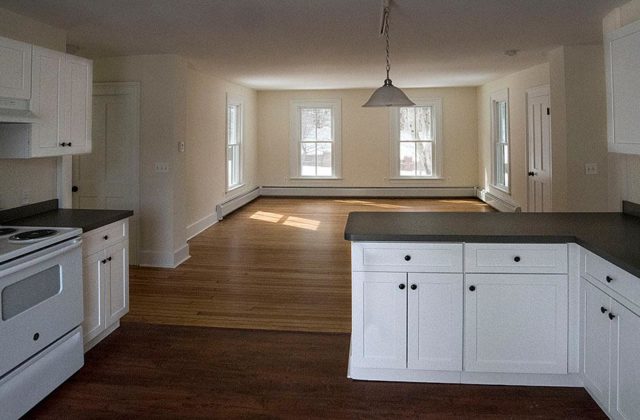Six New Rental Apartments Near Completion in Downtown Norfolk
Some will be rented at below-market rates
By Wiley Wood
The imposing two-story Victorian on the corner of Shepard Road and Route 44 dates to 1860, but with its new roof, new porches front and back, and new color scheme—muted gray with white trim—it looks freshly built.
“It has good bones,” says Lou Barbagallo, as he leads a tour around the structure’s second-floor apartment. The living area has hardwood floors and windows on three sides, giving the space an airy feel. The kitchen is ample in size.

Foundation for Norfolk Living board members Kate Johnson and Lou Barbagallo point out features of an apartment at 4 Shepard Rd.
Barbagallo is president of Foundation for Norfolk Living (FNL), which bought the building two years ago and has just overseen its conversion from a one-family home to a two-unit rental property. The foundation received a substantial grant from the Connecticut Department of Housing (DOH) to create 12 rental units in downtown Norfolk, of which this is one, 10 of them affordable to households with incomes below the area median.
The two bedrooms are pleasant, with corner windows. But they are separated from the large bathroom—with full-sized washer and dryer—by the whole width of the house. “All the floor plans have quirks,” says Kate Johnson, who is accompanying our tour and is also on the board of FNL. “It was an inevitable consequence of the constraints the architects faced.”
A sweeping staircase with a curved wooden bannister leads downstairs to a front entrance hall. Everything is clean and solidly built.
The ground floor unit has already been rented out. “We’ve rented to two local young people,” says Barbagallo. “They’re perfect candidates, and it’s in line with what we always wanted to do, which is to keep young people in town.”
The foundation was started in 2005 with the specific mission of creating lower cost housing in a town where the median house price, at $300,000, was well above the state and the county average. It was widely felt that expensive housing was a factor in the flight of young and working families from the area.
Second-home owners contributed to the town’s tax revenue, but they couldn’t be counted on to respond to emergency fire and ambulance calls, coach soccer, or run bake sales and raffles to fund the cultural enrichment programs at the school. If Norfolk was going to stay a real town, it needed more than high-cost single-family homes.
And the state largely agreed. Since 1990 at least, DOH has recognized a mandate to help developers create housing for lower income families, both in urban and rural areas.
In its early years, FNL looked for ways to build affordable houses on a donated 1.5-acre lot on Old Colony Road, but after the 2008 recession, the foundation started to examine the possibility of converting existing houses to multi-family rentals in the village district. In 2014, FNL optioned the two houses on Shepard Road and received three more on Greenwoods Road East as a gift. The foundation’s application to DOH for a grant in December 2014 was successful, and in March 2015, Governor Malloy anounced that Norfolk’s affordable housing project had been awarded $3 million.
The converted Victorian on the corner of Shepard Road, now known as Landsdown House, is the result of that investment, as is the brick Ursoni House next door to it, where work is still ongoing, and the three recently renovated houses of the Burr donation east of town.
From the second-story porch at the back of Landsdown House, Kate Johnson takes in the scenery—the symmetrical hump of Haystack Mountain on one side, and a vista through trees of the newly finished City Meadow on the other. “It’s a million dollar view,” she says.
The rent for a two-bedroom apartment in one of the Shepard Road houses might be $1,000 to $1,200 per month, Johnson suggests, for a household able to rent at market price. For a lower-income household, the cost might be $400 or $500 per month. The rates includes heat and hot water.
But FNL has to fill its apartments with renters at a specific range of income levels to carry out its business plan and its contract with the state: so many at 25 percent of the area median income, so many at 50 percent, so many at 80 percent, and so many unrestricted. The calculus is complex (median income for a 4-person household in the Litchfield area is $91,700, as of April 2017), and the vetting of applicants, as might be expected, is thorough. The application form is available online at the Foundation for Norfolk Living website.
Realtor Betsy Little believes that long-term rentals in Norfolk are hard to find, whether for working families unwilling to commit to buying a home or downsizing seniors. “They’ve done a really nice job,” she says of FNL, “providing reasonable rentals for people who need them.”
First Selectman Matt Riiska applauds the work of Barbagallo and Johnson. “The whole idea was to open up affordable units to younger people, who volunteer in different ways.” He points out that, despite being a nonprofit, the foundation pays taxes on its buildings on the same basis as any other owner of apartment buildings in town.
Riiska adds, “Both buildings were basically empty for a number of years, and they’re now very attractive. It does a lot to enhance the appearance of downtown.”
Photos by Bruce Frisch.


Good job. The buildings look great.